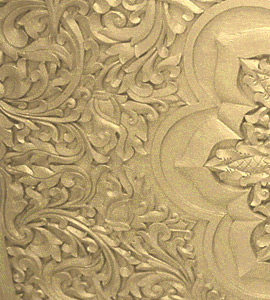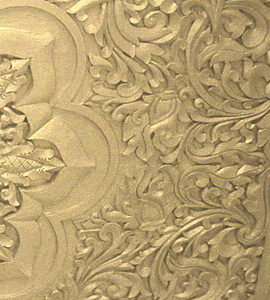


Related Links
Sayagyi U Ba Khin
"Dhamma eradicates suffering and gives happiness. Who gives this happiness? It is not the Buddha but the Dhamma, the knowledge of anicca within the body, which gives the happiness. That is why you must meditate and be aware of anicca continually." - Sayagyi U Ba Khin
Sayagyi U Ba Khin was born in Rangoon, the capital of Burma, on 6th March, 1899. He was the younger of two children in a family of modest means living in a working class district. Burma was ruled by Britain at the time, as it was until after the Second World War. Learning English was therefore very important; in fact, job advancement depended on having a good speaking knowledge of English.
Fortunately, an elderly man from a nearby factory assisted U Ba Khin in entering the Methodist Middle School at the age of eight. He proved a gifted student. He had the ability to commit his lessons to memory, learning his English grammar book by heart from cover to cover. He was first in every class and earned a middle school scholarship. A Burmese teacher helped him gain entrance to St. Paul's Institution, where every year he was again at the head of his high school class.
In March of 1917, he passed the final high school examination, winning a gold medal as well as a college scholarship. But family pressures forced him to discontinue his formal education to start earning money.
His first job was with a Burmese newspaper called The Sun, but after some time he began working as an accounts clerk in the office of the Accountant General of Burma. Few other Burmese were employed in this office since most of the civil servants in Burma at the time were British or Indian. In 1926 he passed the Accounts Service examination, given by the provincial government of India. In 1937, when Burma was separated from India, he was appointed the first Special Office Superintendent.
It was on 1st January, 1937, that Sayagyi tried meditation for the first time. A student of Saya Thetgyi – a wealthy farmer and meditation teacher – was visiting U Ba Khin and explained Anapana meditation to him. When Sayagyi tried it, he experienced good concentration, which impressed him so much that he resolved to complete a full course. Accordingly, he applied for a ten-day leave of absence and set out for Saya Thetgyi's teaching centre.
It is a testament to U Ba Khin's determination to learn Vipassana that he left the headquarters on short notice. His desire to meditate was so strong that only one week after trying Anapana, he was on his way to Saya Thetgyi's centre at Pyawbwegyi.
The small village of Pyawbwegyi is due south of Rangoon, across the Rangoon River and miles of rice paddies. Although it is only eight miles from the city, the muddy fields before harvest time make it seem longer; travellers must cross the equivalent of a shallow sea. When U Ba Khin crossed the Rangoon River, it was low tide, and the sampan boat he hired could only take him to Phyarsu village–about half the distance –along a tributary which connected to Pyawbwegyi. Sayagyi climbed the river bank, sinking in mud up to his knees. He covered the remaining distance on foot across the fields, arriving with his legs caked in mud.
That same night, U Ba Khin and another Burmese student, who was a disciple of Ledi Sayadaw, received Anapana instructions from Saya Thetgyi. The two students advanced rapidly, and were given Vipassana the next day. Sayagyi progressed well during this first ten-day course, and continued his work during frequent visits to his teacher's centre and meetings with Saya Thetgyi whenever he came to Rangoon.
When he returned to his office, Sayagyi found an envelope on his desk. He feared that it might be a dismissal note but found, to his surprise, that it was a promotion letter. He had been chosen for the post of Special Office Superintendent in the new office of the Auditor General of Burma.
In 1941, a seemingly happenstance incident occurred which was to be important in Sayagyi's life. While on government business in upper Burma, he met by chance Webu Sayadaw, a monk who had achieved high attainments in meditation. Webu Sayadaw was impressed with U Ba Khin's proficiency in meditation, and urged him to teach. He was the first person to exhort Sayagyi to start teaching. An account of this historic meeting, and subsequent contacts between these two important figures, is described in the article Ven. Webu Sayadaw and Sayagyi U Ba Khin.
U Ba Khin did not begin teaching in a formal way until about a decade after he first met Webu Sayadaw. Saya Thetgyi also encouraged him to teach Vipassana. On one occasion during the Japanese occupation of Burma, Saya Thetgyi came to Rangoon and stayed with one of his students who was a government official. When his host and other students expressed a wish to see Saya Thetgyi more often, he replied, "I am like the doctor who can only see you at certain times. But U Ba Khin is like the nurse who will see you any time."
Sayagyi's government service continued for another twenty-six years. He became Accountant General on 4th January, 1948, the day Burma gained independence. For the next two decades, he was employed in various capacities in the government, most of the time holding two or more posts, each equivalent to the head of a department. At one time he served as head of three separate departments simultaneously for three years and, on another occasion, head of four departments for about one year. When he was appointed as the chairman of the State Agricultural Marketing Board in 1956, the Burmese government conferred on him the title of "Thray Sithu," a high honorary title. Only the last four years of Sayagyi's life were devoted exclusively to teaching meditation. The rest of the time he combined his skill in meditation with his devotion to government service and his responsibilities to his family. Sayagyi was a married householder with five daughters and one son.
In 1950 he founded the Vipassana Association of the Accountant General's Office where lay people, mainly employees of that office, could learn Vipassana. In 1952, the International Meditation Centre (I.M.C.) was opened in Rangoon, two miles north of the famous Shwedagon Pagoda. Here many Burmese and foreign students had the good fortune to receive instruction in the Dhamma from Sayagyi.
Sayagyi was active in the planning for the Sixth Council known as Chatta Sangayana (Sixth Recitation) which was held in 1954-56 in Rangoon. Sayagyi was a founding member in 1950 of two organizations which were later merged to become the Union of Burma Buddha Sasana Council (U.B.S.C.), the main planning body for the Great Council. U Ba Khin served as an executive member of the U.B.S.C. and as chairman of the committee for patipatti (practice of meditation).
He also served as honorary auditor of the Council and was therefore responsible for maintaining the accounts for all dana (donation) receipts and expenditures. There was an extensive building programme spread over 170 acres to provide housing, dining areas and kitchen, a hospital, library, museum, four hostels and administrative buildings. The focal point of the entire enterprise was the Maha Pasanaguha (Great Cave), a massive hall where approximately five thousand monks from Burma, Sri Lanka, Thailand, India, Cambodia and Laos gathered to recite, purify, edit and publish the Tipitaka (scriptures). The monks, working in groups, prepared the Pali texts for publication, comparing the Burmese, Sri Lankan Thai, and Cambodian editions and the Roman-script edition of the Pali Text Society in London. The corrected and approved texts were recited in the Great Cave. Ten to fifteen thousand lay men and women came to listen to the recitations of the monks.
To efficiently handle the millions in donations that came for this undertaking, U Ba Khin created a system of printing receipt books on different coloured paper for different amounts of dana, ranging from the humblest donation up to very large amounts. Only selected people were allowed to handle the larger contributions, and every donation was scrupulously accounted for, avoiding any hint of misappropriation.
Sayagyi remained active with the U.B.S.C. in various capacities until 1967. In this way he combined his responsibilities and talents as a layman and government official with his strong Dhamma volition to spread the teaching of Buddha. In addition to the prominent public service he gave to that cause, he continued to teach Vipassana regularly at his centre. Some of the Westerners who came to the Sixth Council were referred to Sayagyi for instruction in meditation since at that time there was no other teacher of Vipassana who was fluent in English.
Because of his highly demanding government duties, Sayagyi was only able to teach a small number of students. Many of his Burmese students were connected with his government work. Many Indian students were introduced by S N Goenka. Sayagyi's students from abroad were small in number but diverse, including leading Western Buddhists, academicians, and members of the diplomatic community in Rangoon.
From time to time, Sayagyi was invited to address foreign audiences in Burma on the subject of Dhamma. On one occasion, for example, he was asked to deliver a series of lectures at the Methodist Church in Rangoon. These lectures were published as a booklet titled "What Buddhism is." Copies were distributed to Burmese embassies and various Buddhist organisations around the world. This booklet attracted a number of Westerners to attend courses with Sayagyi. On another occasion he delivered a lecture to a group of press representatives from Israel, who were in Burma on the occasion of the visit of Israel's prime minister, David Ben Gurion. This lecture was later published under the title "The Real Values of True Buddhist Meditation."
Sayagyi finally retired from his outstanding career in government service in 1967. From that time, until his death in 1971, he stayed at I.M.C., teaching Vipassana. Shortly before his death he thought back to all those who had helped him – the old man who had helped him start school, the Burmese teacher who helped him join St. Paul's and, among many others, one friend whom he had lost sight of over forty years earlier and now found mentioned in the local newspaper. He dictated letters addressed to this old friend and to some foreign students and disciples, including Dr. S.N. Goenka. On the 18th of January, Sayagyi suddenly became ill. When his newly rediscovered friend received Sayagyi's letter on the 20th, he was shocked to read Sayagyi's death announcement in the same post.
Shri S.N. Goenka was in India conducting a course when news of his teacher's death reached him. He sent a telegram back to I.M.C. which contained the famous Pali verse:
Anicca vata sankhara, uppadavaya-dhammino.
Uppajjitva nirujjhanti, tesam vupasamo sukho.
Impermanent truly are compounded things, by nature arising and passing away.
If they arise and are extinguished, their eradication brings happiness.
One year later, in a tribute to his teacher, Mr. S.N. Goenka wrote: "Even after his passing away one year ago, observing the continued success of the courses, I get more and more convinced that it is his metta (loving-kindness) force which is giving me all the inspiration and strength to serve so many people – Obviously the force of Dhamma is immeasurable."
Sayagyi's aspirations are being accomplished. The Buddha's teachings, carefully preserved all these centuries, are still being practiced, and are still bringing results here and now.

